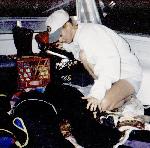|
|
|
Ann Spellman to the rescue |
To: Journey North
From: Ann Spellman
March 11, 1998
Since my rescue report last year for Journey North, state manatee biologists have been busy as usual. On the Central East Coast of Florida near Cocoa Beach, for example, two school children discovered something interesting one morning and called Manatee rescuers into action for a very unique rescue!
Students Help Rescuers!
Just last month, on February 11th, two school children who were waiting for their bus, looked down into a storm drain grate. What they saw prompted them to call the police. Once again a manatee had swam into the storm pipe and was trapped. And once again, we were called in to get her out.
Crawling With Spiders...Black Widow Spiders!
To complicate matters, the pipe was filled with not only varying water levels throughout, but was home to thousands of roaches and spiders, black widow spiders in particular.
And this storm pipe rescue was even a little more difficult for two reasons. First, the pipe where the manatee was found was only 35" in diameter, and second, something unexpected waited for us down in the pipe.
Something Was Breathing Behind Me, Was It An Alligator or a Manatee?
While waiting for the rest of the rescue team, I crawled down into the pipe along with a local fireman, to measure the manatee and to assess the situation, as well as the manatee's health. While kneeling in the small, dark, spider-infested hole, I heard something expel air behind me. There were only two possibilities. It was either an alligator or another manatee. Taking the flashlight from the fireman, I pointed it in the direction of the breathing noise. Sure enough, there was a second manatee 40' further into the pipe. I crawled to the manatee and found another 7' female in as bad a shape as the first.
An Even Tighter Squeeze
Shortly after measuring both manatees and exiting the pipe, the rest of the team from Sea World arrived, and I informed them of the second manatee. Because the pipe was so narrow, room to move would be scarce. We decided to move the manatee under the grate first, but only far enough so that we could pull the second manatee up to the same grate. This way, we could leave part of the team with the second manatee to monitor its condition, while the rest of the team worked at removing the first one. So the first manatee was loaded into a stretcher and moved 10' into the pipe.
The only way to get to the head of the second manatee was to enter the storm drain 410' south of where she was trapped. Four of us entered that way while the others stayed at the tail. Using a long, long piece of plastic sheeting, we slipped the plastic under the second manatee and literally slid the manatee backwards to the grate 40' feet away. Once this was done, we started the long trek through the pipe with the first manatee. The water level this time varied greatly. Sometimes we were up to our chins in water, while at other times there was only 2-4", and there were plenty of bugs and spiders. There were even blue crabs and fish down there with us.
The trip this time went relatively fast, and within 90 minutes, the first manatee was on its way out of the dark hole. The second manatee's extraction went smoothly as well, and the entire event was over within five hours of the manatees' discovery. In the end, rescuers crawled through over 1000' of storm water pipe, spent upwards of three hours 6' underground and partially submerged, surrounded by bugs, crabs and poisonous spiders, and not one of our team members was injured in any way. Both manatees turned out to be females, approximately 7' long each, and each weighing in at just over 500 lbs. Both are now at Sea World and are doing well. They will be released in the next few months.
Manatee-Proofing the Drains
As for the City of Cocoa Beach, they were directed by the U.S. Fish & Wildlife to make immediate modifications to the entrance of the storm drain and put a manatee-proof barrier up, so that we would not have to go through this again in another six months. The City complied with the directive within 24 hours.
Skipping School
And what became of the two school kids who found the first manatee...? Well, they received lifetime memberships to the Save the Manatee club, tickets to Sea World, plaques from the city of Cocoa Beach, and letters of recognition from the DEP. Oh yeah, they also got to skip school to watch the rescues! All in all, not a bad day for man nor manatee.
- Click here to visit Ann's extensive report on manatee rescues from last year









